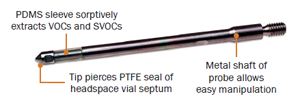Markes International has produced a series of application notes that provide detailed studies of flavour profiling of a variety of beverages by high-capacity sorptive extraction with analysis by thermal desorption–gas chromatography–mass spectrometry (TD–GC–MS). The beverages under investigation were milk, filter coffee, herbal infusions, alchoholic spirits and premium teas.
 Introduction
Introduction
A wide range of volatile and semi-volatile organic compounds (VOCs and SVOCs) that determine the flavour of the beverages under investigation can be identified by high-capacity sorptive extraction using a HiSorb™ PDMS probe, with analysis by thermal desorption–gas chromatography–mass spectrometry (TD–GC–MS).
 Background to HiSorb
Background to HiSorb
Markes International’s HiSorb system allows high capacity sorptive extraction from liquids and solids. Samples are placed inside standard 20 mL or 10 mL vials, sealed with a crimped HiSorb septum cap, and a metal-core PDMS HiSorb probe inserted into the vial for either immersive or headspace sampling. The vial and probe are agitated and heated using the HiSorb Agitator, and after this the probe is washed, dried, and inserted into a conventional TD tube for direct desorption and automated TD–GC–MS analysis.
Conclusion
In conclusion, this study has shown the ability of HiSorb sorptive extraction, combined with analysis by automated TD, to aid the rapid flavour profiling of various beverages. The high-capacity PDMS phase results in higher sample loadings than SPME methods, and (combined with Markes’ TD pre-concentration
technology) offers greater sensitivity across a wider analyte range, in a single run. A further benefit is provided by the unique capability of Markes’ instruments to re-collect all split flows, allowing repeat analysis for sample security, method optimisation and characterisation by alternative detection
methods.




